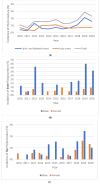Changing Incidence, Aetiology and Outcomes of Prosthetic Joint Infections: A Population-Based Study in Iceland
- PMID: 40806913
- PMCID: PMC12347521
- DOI: 10.3390/jcm14155289
Changing Incidence, Aetiology and Outcomes of Prosthetic Joint Infections: A Population-Based Study in Iceland
Abstract
Background/Objectives: The rising demand for total joint arthroplasty (TJA) and increasing incidence of prosthetic joint infections (PJIs) significantly burden patients and healthcare systems. This retrospective study describes the epidemiology, clinical characteristics and outcomes of PJIs in Iceland from 2003 to 2020. Methods: PJI cases were identified through synovial fluid cultures and ICD codes, with classification per EBJIS criteria. Unlikely cases were excluded. Results: Among 293 cases with a mean age of 70 years, 60% (176/293) were males and 58% (171/293) involved the knee. Over half of infections occurred within two years post TJA, with an incidence rate of 0.94%, increasing significantly over time (p = 0.012). Males had significantly higher incidence rates than females (incidence rate ratio 0.42; p < 0.001). The most common pathogens were coagulase-negative staphylococci (30%, 88/293), and 9% (27/293) of cases were culture-negative. DAIR was the first-line treatment in about 50% (147/293) of cases but it failed in nearly half, contributing to an overall treatment failure rate of 38% (98/259). PJI-related mortality was 2% (6/293). Conclusions: The results indicate an increased incidence, with the highest risk within two years of TJA. Males are at greater risk, while females more commonly undergo TJA. DAIR success rates were lower than reported elsewhere but improved significantly over time. Better methods to prevent PJIs are needed.
Keywords: arthroplasty; debridement; epidemiology; incidence; microbiology; prosthesis-related infections; treatment outcome.
Conflict of interest statement
The authors declare no conflicts of interest.
Figures


Similar articles
-
What Is the Incidence of and Outcomes After Debridement, Antibiotics, and Implant Retention (DAIR) for the Treatment of Periprosthetic Joint Infections in the AJRR Population?Clin Orthop Relat Res. 2024 Nov 1;482(11):2042-2051. doi: 10.1097/CORR.0000000000003138. Epub 2024 Aug 19. Clin Orthop Relat Res. 2024. PMID: 39246104
-
High Rates of Treatment Failure and Amputation in Modular Endoprosthesis Prosthetic Joint Infections Caused by Fungal Infections With Candida.Clin Orthop Relat Res. 2024 Jul 1;482(7):1232-1242. doi: 10.1097/CORR.0000000000002918. Epub 2023 Nov 21. Clin Orthop Relat Res. 2024. PMID: 37988003 Free PMC article.
-
Prescription of Controlled Substances: Benefits and Risks.2025 Jul 6. In: StatPearls [Internet]. Treasure Island (FL): StatPearls Publishing; 2025 Jan–. 2025 Jul 6. In: StatPearls [Internet]. Treasure Island (FL): StatPearls Publishing; 2025 Jan–. PMID: 30726003 Free Books & Documents.
-
A rapid and systematic review of the clinical effectiveness and cost-effectiveness of paclitaxel, docetaxel, gemcitabine and vinorelbine in non-small-cell lung cancer.Health Technol Assess. 2001;5(32):1-195. doi: 10.3310/hta5320. Health Technol Assess. 2001. PMID: 12065068
-
Is Your Surgical Helmet System Compromising the Sterile Field? A Systematic Review of Contamination Risks and Preventive Measures in Total Joint Arthroplasty.Clin Orthop Relat Res. 2025 Jun 1;483(6):972-990. doi: 10.1097/CORR.0000000000003383. Epub 2025 Feb 5. Clin Orthop Relat Res. 2025. PMID: 39915114
References
-
- Akgün D., Müller M., Perka C., Winkler T. The serum level of C-reactive protein alone cannot be used for the diagnosis of prosthetic joint infections, especially in those caused by organisms of low virulence. Bone Jt. J. 2018;100-B:1482–1486. doi: 10.1302/0301-620X.100B11.BJJ-2018-0514.R1. - DOI - PubMed
Grants and funding
LinkOut - more resources
Full Text Sources

